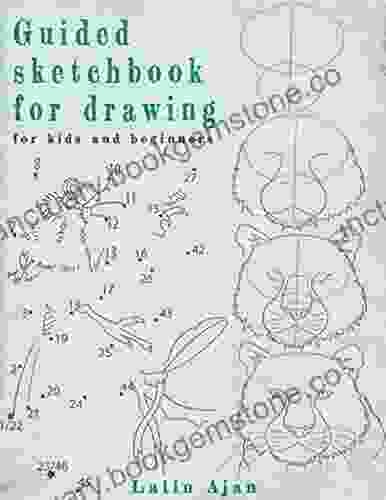Screenprinting On Textiles: The Complete Guide

Screenprinting is a versatile and rewarding craft that can be used to create beautiful and unique designs on a variety of fabrics. It's a great way to add your own personal touch to clothing, home décor, and other items. Screenprinting is also a relatively inexpensive and easy-to-learn craft, making it a great option for beginners.
4.3 out of 5
| Language | : | English |
| File size | : | 79715 KB |
| Text-to-Speech | : | Enabled |
| Screen Reader | : | Supported |
| Enhanced typesetting | : | Enabled |
| Print length | : | 224 pages |
Materials
To get started with screenprinting, you will need the following materials:
- A screenprinting frame
- A squeegee
- Ink
- Fabric
- A light source
- A darkroom
Screenprinting Frame
The screenprinting frame is the most important piece of equipment you will need. It is used to hold the screen in place while you are printing. Frames come in a variety of sizes, so choose one that is appropriate for the size of your designs.
Squeegee
The squeegee is used to apply ink to the screen. Squeegees come in a variety of shapes and sizes, so choose one that is comfortable for you to use.
Ink
There are a variety of different types of ink that can be used for screenprinting. The type of ink you choose will depend on the fabric you are printing on. Water-based inks are the most common type of ink used for screenprinting on textiles.
Fabric
You can screenprint on a variety of different fabrics, but some fabrics are more suitable than others. Natural fibers, such as cotton and linen, are the best fabrics for screenprinting. Synthetic fabrics, such as polyester and nylon, can also be screenprinted, but they require a different type of ink.
Light Source
A light source is used to expose the screen to light. This process hardens the emulsion on the screen, which creates the design. You can use a variety of different light sources, such as a sun lamp or a UV lamp.
Darkroom
A darkroom is a room that is completely dark. It is used to develop the screen after it has been exposed to light. You can create a makeshift darkroom by covering a room with black plastic or cloth.
Steps
Once you have gathered all of your materials, you can begin the screenprinting process.
- Prepare the screen. The first step is to prepare the screen. This involves coating the screen with a light-sensitive emulsion and then exposing it to light.
- Apply ink to the screen. Once the screen is prepared, you can apply ink to it. Use a squeegee to apply a thin layer of ink to the screen.
- Place the fabric on the screen. Place the fabric on the screen and align it with the design.
- Print the design. Use the squeegee to print the design onto the fabric. Apply even pressure to the squeegee and pull it across the screen in one smooth motion.
- Cure the ink. Once the design has been printed, it needs to be cured. This can be done by placing the fabric in a dryer or by exposing it to heat.
- Wash the fabric. Once the ink has been cured, the fabric can be washed. This will remove any excess ink and help to set the design.
Tips
Here are a few tips for screenprinting on textiles:
- Use a high-quality emulsion. The emulsion is what holds the design on the screen, so it is important to use a high-quality emulsion that will not break down over time.
- Expose the screen to light for the correct amount of time. If the screen is exposed to light for too long, the emulsion will harden and the design will not be visible. If the screen is not exposed to light for long enough, the emulsion will not harden and the design will be blurry.
- Apply ink to the screen evenly. If the ink is not applied evenly, the design will be uneven.
- Print the design onto the fabric carefully. If the fabric is not aligned properly, the design will be crooked.
- Cure the ink according to the manufacturer's instructions. If the ink is not cured properly, it will not be permanent.
Screenprinting on textiles is a versatile and rewarding craft that can be used to create beautiful and unique designs on a variety of fabrics. It is a relatively inexpensive and easy-to-learn craft, making it a great option for beginners. With a little practice, you can create beautiful screenprinted designs that will add your own personal touch to clothing, home décor, and other items.
4.3 out of 5
| Language | : | English |
| File size | : | 79715 KB |
| Text-to-Speech | : | Enabled |
| Screen Reader | : | Supported |
| Enhanced typesetting | : | Enabled |
| Print length | : | 224 pages |
Do you want to contribute by writing guest posts on this blog?
Please contact us and send us a resume of previous articles that you have written.
 Best Book
Best Book Page Flip
Page Flip Bookshelf
Bookshelf Literary loom
Literary loom Chapter
Chapter Bookish
Bookish PageTurner
PageTurner Bibliophile
Bibliophile Story
Story Inkwell
Inkwell Bookworm
Bookworm Labyrinth
Labyrinth Plot Twist
Plot Twist Prose
Prose Paperback
Paperback Storyteller
Storyteller Sanctuary
Sanctuary Fiction
Fiction Reading
Reading Chronicle
Chronicle Read
Read Christie Taylor
Christie Taylor Xander Black
Xander Black Jack Gernsheimer
Jack Gernsheimer Annalee Newitz
Annalee Newitz Andrew Osmond
Andrew Osmond Andy Mcdermott
Andy Mcdermott Jill Braden
Jill Braden Andy Herbach
Andy Herbach Tiffany L Warren
Tiffany L Warren Andy Davidson
Andy Davidson Edward Bellamy
Edward Bellamy Catherine Berry
Catherine Berry Andrew Bowden
Andrew Bowden Sarah Herman
Sarah Herman Maggie O Farrell
Maggie O Farrell Danielle Geller
Danielle Geller Anjan Chatterjee
Anjan Chatterjee Luis Carlos Montalvan
Luis Carlos Montalvan Ronnie Smith
Ronnie Smith Michael Asher
Michael Asher Nina Willner
Nina Willner Tony Wheeler
Tony Wheeler Andrew Tunstall
Andrew Tunstall Angie Daniels
Angie Daniels Leslie Redhead
Leslie Redhead Anna Corba
Anna Corba Terry Newman
Terry Newman Dorothy Hartley
Dorothy Hartley E B Sledge
E B Sledge Angelo Colorni
Angelo Colorni Gary Spetz
Gary Spetz John C Cranham Dds
John C Cranham Dds Jeremy Mercer
Jeremy Mercer Sara Funduk
Sara Funduk Angie Martinez
Angie Martinez Andrea Fazzari
Andrea Fazzari Juanitta Baldwin
Juanitta Baldwin Anita Heiss
Anita Heiss Andrew Sutton
Andrew Sutton Carlos Del Amor
Carlos Del Amor Gary Faigin
Gary Faigin L T Ryan
L T Ryan Andrea Pflaumer
Andrea Pflaumer Jamila Jasper
Jamila Jasper Anna Bartlett
Anna Bartlett Katrina Mcpherson
Katrina Mcpherson Anna Starmer
Anna Starmer Legacy Russell
Legacy Russell Elizabeth L Block
Elizabeth L Block Heather Galler
Heather Galler Lyonel Feininger
Lyonel Feininger Angelique V Nixon
Angelique V Nixon Marc Shapiro
Marc Shapiro Mia Sheridan
Mia Sheridan Natasha Solomons
Natasha Solomons Dina Nayeri
Dina Nayeri Angus Donald
Angus Donald Ed Duncan
Ed Duncan Ted Kerasote
Ted Kerasote John M Olsen
John M Olsen Louise Egerton
Louise Egerton Sergio Bizzio
Sergio Bizzio Jeffrey Chipps Smith
Jeffrey Chipps Smith Anette Fischer
Anette Fischer Pao Lor
Pao Lor Andrew Moor
Andrew Moor Nicholas Roerich
Nicholas Roerich Andrew Bostock
Andrew Bostock Tetiana Elert
Tetiana Elert Roman Frister
Roman Frister Padma Lakshmi
Padma Lakshmi Frank Kennedy
Frank Kennedy Patrick Smithwick
Patrick Smithwick Susan Ross
Susan Ross Charla Krupp
Charla Krupp Van Lu
Van Lu Andy Mckell
Andy Mckell Bruce Feiler
Bruce Feiler Kindle Edition With Audio Video
Kindle Edition With Audio Video G J Younghusband
G J Younghusband Gavin Ambrose
Gavin Ambrose Joseph E Persico
Joseph E Persico Ann Marks
Ann Marks Andrew Mayne
Andrew Mayne Larry Silverberg
Larry Silverberg Anna Jean Mayhew
Anna Jean Mayhew Clemantine Wamariya
Clemantine Wamariya Tim Slessor
Tim Slessor Ernest Hemingway
Ernest Hemingway Anita Nipane
Anita Nipane John Charles Bennett
John Charles Bennett Barbara Sillery
Barbara Sillery Angela Hunt
Angela Hunt Anna Koliadych
Anna Koliadych Shellise Berry
Shellise Berry Ann Hoffman
Ann Hoffman J C Cooper
J C Cooper Andrea Pomerantz Lustig
Andrea Pomerantz Lustig Lynda Vaughn
Lynda Vaughn Erin Lewis Fitzgerald
Erin Lewis Fitzgerald Tina Brown
Tina Brown Lakisha Johnson
Lakisha Johnson Andrea Erickson
Andrea Erickson Kliph Nesteroff
Kliph Nesteroff Julie Ann Walker
Julie Ann Walker Anna Pasternak
Anna Pasternak Christopher S Wood
Christopher S Wood Nintendo
Nintendo Phoenix Collins
Phoenix Collins Andrew Johnson
Andrew Johnson Andy Southall
Andy Southall Angela Gaughan
Angela Gaughan Raymond F Jones
Raymond F Jones Carole Jackson
Carole Jackson R G Richardson
R G Richardson Royal Horticultural Society
Royal Horticultural Society Anna Badkhen
Anna Badkhen Jane Akshar
Jane Akshar Anna M Mazur
Anna M Mazur Ani Trime
Ani Trime Nancy Princenthal
Nancy Princenthal Waldemar Bogoras
Waldemar Bogoras Barbara Lasalle
Barbara Lasalle Andrew Grant
Andrew Grant Kent Wong
Kent Wong Monica Moody
Monica Moody Anna Cavallo
Anna Cavallo Angharad Lewis
Angharad Lewis Frederick Stirton Weaver
Frederick Stirton Weaver Jean Ann Shirey
Jean Ann Shirey Simon Schama
Simon Schama Andrew Vaillencourt
Andrew Vaillencourt Christopher Fowler
Christopher Fowler Anna Goldenberg
Anna Goldenberg J N Chaney
J N Chaney Anjelah Johnson Reyes
Anjelah Johnson Reyes Ernesto Che Guevara
Ernesto Che Guevara Milton Glaser
Milton Glaser Wendy Jelbert
Wendy Jelbert Ann C Hall
Ann C Hall Jane Hamilton
Jane Hamilton Anne C Heller
Anne C Heller Emma Newman
Emma Newman Annabel Chase
Annabel Chase Scott Bartlett
Scott Bartlett Jake Sherman
Jake Sherman Laurinda Reddig
Laurinda Reddig Eric Seale
Eric Seale Christine Leteux
Christine Leteux Stephanie Laurens
Stephanie Laurens Emily Bingham
Emily Bingham Andrew M Dobell
Andrew M Dobell Anna Kirtlan
Anna Kirtlan Lisa Dickey
Lisa Dickey Isabel Allende
Isabel Allende Kat Chow
Kat Chow Harriet Welty Rochefort
Harriet Welty Rochefort Theodore Annemann
Theodore Annemann Andrew Dickos
Andrew Dickos Sherry Ginn
Sherry Ginn Bridget Alsdorf
Bridget Alsdorf Jeb Rosebrook
Jeb Rosebrook Anna Salton Eisen
Anna Salton Eisen Dita Von Teese
Dita Von Teese Josie Iselin
Josie Iselin Quincy Jones
Quincy Jones Camil Flores
Camil Flores Jocelyn Harewood
Jocelyn Harewood Lonneke Geerlings
Lonneke Geerlings E M Foner
E M Foner James T Deshields
James T Deshields Angus M Gunn
Angus M Gunn Angelina Jolie
Angelina Jolie Graeme Davis
Graeme Davis Stacey L Nash
Stacey L Nash Anne Billson
Anne Billson Shel Perkins
Shel Perkins Paul Robert Walker
Paul Robert Walker Dominique Auzias
Dominique Auzias Andrei Codrescu
Andrei Codrescu Marina Benjamin
Marina Benjamin John Driver
John Driver Andrew Meier
Andrew Meier Lance Esplund
Lance Esplund Anna Stephens
Anna Stephens Robert Alan Brookey
Robert Alan Brookey Glenn Adamson
Glenn Adamson Shannon Leone Fowler
Shannon Leone Fowler Diane Esguerra
Diane Esguerra Betty Arnett
Betty Arnett Disamis Arcia Munoz
Disamis Arcia Munoz Emily Louise Howard
Emily Louise Howard Zachary Lamothe
Zachary Lamothe Stephen Kurkjian
Stephen Kurkjian Andy Keen
Andy Keen John Patrick Bray
John Patrick Bray Kent Babb
Kent Babb Nicole Grotepas
Nicole Grotepas Josh Hanagarne
Josh Hanagarne Anna Mocikat
Anna Mocikat Scott Thybony
Scott Thybony Cornel West
Cornel West Anna Malaika Tubbs
Anna Malaika Tubbs James Martin
James Martin Anita Brookner
Anita Brookner Jarrett Brandon Early
Jarrett Brandon Early Hilary Spurling
Hilary Spurling Billy Ray Belcourt
Billy Ray Belcourt Sam Fury
Sam Fury Taylor Michaels
Taylor Michaels Elaine Welteroth
Elaine Welteroth Andrew Hund
Andrew Hund Jenny Schwartz
Jenny Schwartz Anjali Enjeti
Anjali Enjeti Angel Williams
Angel Williams Andrew Moriarty
Andrew Moriarty J B Rosenberg
J B Rosenberg Emiko Davies
Emiko Davies Andrew Karevik
Andrew Karevik Judy Omar
Judy Omar Scott Baron
Scott Baron William J Lederer
William J Lederer Angela Wolf
Angela Wolf Fawzia Koofi
Fawzia Koofi David Loud
David Loud Ann C Smith
Ann C Smith Royd Tolkien
Royd Tolkien Anna Todd
Anna Todd Tom Sileo
Tom Sileo Farha Ghannam
Farha Ghannam Harry Houdini
Harry Houdini W H Bartlett
W H Bartlett Andrew Delaplaine
Andrew Delaplaine Ann Aguirre
Ann Aguirre Val Wake
Val Wake Sarah Ferguson
Sarah Ferguson Ann Budd
Ann Budd Annie Dillard
Annie Dillard Mari K Eder
Mari K Eder Octave Uzanne
Octave Uzanne Haley Hoover
Haley Hoover Steven Bleicher
Steven Bleicher Andrew Dewar
Andrew Dewar Manuel Huitzilli
Manuel Huitzilli Shirley Anstis
Shirley Anstis Angus Roxburgh
Angus Roxburgh Andrew Mcmahon
Andrew Mcmahon David Blatner
David Blatner Jack Lucas
Jack Lucas Andrew Parker
Andrew Parker George Kalmpourtzis
George Kalmpourtzis Rita Moreno
Rita Moreno Duncan Heath
Duncan Heath Laura Bradbury
Laura Bradbury Frederic Lombardi
Frederic Lombardi Christopher Greyson
Christopher Greyson Melissa Riddell
Melissa Riddell Kimberly Brock
Kimberly Brock Rickie Lee Jones
Rickie Lee Jones D C Robinson
D C Robinson Robin Koontz
Robin Koontz Anna Deavere Smith
Anna Deavere Smith Anne Pannecke
Anne Pannecke Elisa Russell
Elisa Russell Jeff Fletcher
Jeff Fletcher Caroline Linscott
Caroline Linscott Terry Brooks
Terry Brooks Walter Foster
Walter Foster Godfrey Baldacchino
Godfrey Baldacchino J D Robb
J D Robb Kindle Edition
Kindle Edition Ys Publishing
Ys Publishing Guy Stern
Guy Stern C Y Croc
C Y Croc Patricia Preciado Martin
Patricia Preciado Martin Andreas Marks
Andreas Marks Maxim Peter Griffin
Maxim Peter Griffin Andrei Besedin
Andrei Besedin Angelico Chavez
Angelico Chavez Bathroom Readers Institute
Bathroom Readers Institute Michael Howard
Michael Howard Gabrielle Moss
Gabrielle Moss Stuart Campbell
Stuart Campbell Dawnie Walton
Dawnie Walton Michiyo
Michiyo Andreas Deja
Andreas Deja Ruskin Bond
Ruskin Bond L J Martin
L J Martin J Bright
J Bright Kitty Gorrell
Kitty Gorrell Dave Clayton
Dave Clayton Erwin Panofsky
Erwin Panofsky Condoleezza Rice
Condoleezza Rice Anna Nadler
Anna Nadler Don Bluth
Don Bluth Drew Kwong
Drew Kwong Crystal Daniels
Crystal Daniels Brian Shea
Brian Shea Michael Punke
Michael Punke T J Demos
T J Demos Bill Fawcett
Bill Fawcett Andrew Juniper
Andrew Juniper Andrew Wilson
Andrew Wilson Sylvan Barnet
Sylvan Barnet John F Mullins
John F Mullins B Love
B Love Andy Mcnab
Andy Mcnab Anne Bogart
Anne Bogart Jane Dunnewold
Jane Dunnewold James Canton
James Canton Ryan White
Ryan White Henry Van Dyke
Henry Van Dyke Mark Horrell
Mark Horrell Joshua Rivkin
Joshua Rivkin Cissy Houston
Cissy Houston Flavio Ferrari Zumbini
Flavio Ferrari Zumbini David Hampshire
David Hampshire Magic Guidebooks
Magic Guidebooks Michelle Lee
Michelle Lee William W Johnstone
William W Johnstone Zane Lamprey
Zane Lamprey Kianna Alexander
Kianna Alexander Erika Warmbrunn
Erika Warmbrunn Andrew Forkner
Andrew Forkner Jack Porter
Jack Porter Denys Johnson Davies
Denys Johnson Davies Anna Hackett
Anna Hackett Diana Gabaldon
Diana Gabaldon Ray Scippa
Ray Scippa Liz Neves
Liz Neves Julie Klassen
Julie Klassen Mark Henwick
Mark Henwick David Nees
David Nees D C Palter
D C Palter Ann Beaglehole
Ann Beaglehole Martin Cruz Smith
Martin Cruz Smith Angela D French
Angela D French Chris Weyers
Chris Weyers Caroline James
Caroline James Charles Reid
Charles Reid Ann Blockley
Ann Blockley Doris Kennedy
Doris Kennedy Ben G Frank
Ben G Frank Michele Sullivan
Michele Sullivan Andrew Darby
Andrew Darby Fred Saberhagen
Fred Saberhagen Kristina Liu
Kristina Liu Howard Thurston
Howard Thurston Jason Sommer
Jason Sommer Sylvia Day
Sylvia Day Daniella Weiss Ashkenazy
Daniella Weiss Ashkenazy Robin Sloan
Robin Sloan Jonathan Rauch
Jonathan Rauch Kate Frost
Kate Frost Andrew Marble
Andrew Marble Charlie English
Charlie English Andy Warhol
Andy Warhol Donald Preziosi
Donald Preziosi Dominic Roskrow
Dominic Roskrow John Gilstrap
John Gilstrap John Sugden
John Sugden Michael Tubbs
Michael Tubbs Alex Tannen
Alex Tannen C L Parker
C L Parker Octavio Solis
Octavio Solis Jason Kramar
Jason Kramar Andrew Porwancher
Andrew Porwancher David Mamet
David Mamet Yossi Maimon
Yossi Maimon Jessica Alba
Jessica Alba Andrew Cunningham
Andrew Cunningham Holly Moss
Holly Moss Andrew Carroll
Andrew Carroll Angus Johnstone
Angus Johnstone David J Dennis Jr
David J Dennis Jr Yan Lianke
Yan Lianke Bernie Marcus
Bernie Marcus Denny S Bryce
Denny S Bryce Shawn Kelly
Shawn Kelly Laura Lee
Laura Lee Angie Grace
Angie Grace Cion Lee
Cion Lee Hamish Bowles
Hamish Bowles Rob Craig
Rob Craig Andrea Lee
Andrea Lee Ann Cleeves
Ann Cleeves Siren
Siren Charles Bukowski
Charles Bukowski Fern Michaels
Fern Michaels Christina Klein
Christina Klein Edward Seidensticker
Edward Seidensticker Rhonda Mcknight
Rhonda Mcknight Andrew Graham Dixon
Andrew Graham Dixon Rachel Rubin Wolf
Rachel Rubin Wolf Angela Marie Moulton
Angela Marie Moulton Mike Epps
Mike Epps Mary Robinette Kowal
Mary Robinette Kowal Robert Ludlum
Robert Ludlum Andrew Haslam
Andrew Haslam Anna Qu
Anna Qu Annabelle Honess Roe
Annabelle Honess Roe Margaret Wander Bonanno
Margaret Wander Bonanno Paul Reps
Paul Reps Kristina Kozak
Kristina Kozak Nicholas Meyer
Nicholas Meyer Andrew Vietze
Andrew Vietze Anna Paola Sanna
Anna Paola Sanna Kevin Grange
Kevin Grange Anika Fajardo
Anika Fajardo Marie Force
Marie Force Marilyn Chase
Marilyn Chase Regine Abel
Regine Abel Darrin Duford
Darrin Duford Kien Nguyen
Kien Nguyen Andrea Jackson
Andrea Jackson Liao Yiwu
Liao Yiwu Anna Sherman
Anna Sherman Danielle Prescod
Danielle Prescod Kathryn Wilder
Kathryn Wilder Angie Cruz
Angie Cruz Fred Botting
Fred Botting
Light bulbAdvertise smarter! Our strategic ad space ensures maximum exposure. Reserve your spot today!

 Caleb CarterThe Disneyanity of Walt and Religion: Exploring the Intersections of Faith...
Caleb CarterThe Disneyanity of Walt and Religion: Exploring the Intersections of Faith... Giovanni MitchellFollow ·4k
Giovanni MitchellFollow ·4k Henry Wadsworth LongfellowFollow ·3.9k
Henry Wadsworth LongfellowFollow ·3.9k Jeff FosterFollow ·11k
Jeff FosterFollow ·11k Johnny TurnerFollow ·17.3k
Johnny TurnerFollow ·17.3k Ignacio HayesFollow ·9.8k
Ignacio HayesFollow ·9.8k Allan JamesFollow ·17.9k
Allan JamesFollow ·17.9k Langston HughesFollow ·9.6k
Langston HughesFollow ·9.6k H.G. WellsFollow ·17.8k
H.G. WellsFollow ·17.8k

 Ethan Mitchell
Ethan MitchellWe Are Here To Hurt Each Other: A Deep Dive into the...
Yes, I can help you with that. Here is an...

 Xavier Bell
Xavier BellHannah Arendt: A Life in Dark Times
Hannah Arendt was a...

 Donovan Carter
Donovan CarterThe Art of Looking: A Comprehensive Exploration of Visual...
: The Power of...

 Terence Nelson
Terence NelsonUnveiling the Secrets of Moscow's Red Square: A Journey...
In the heart of Moscow,...

 Cruz Simmons
Cruz SimmonsDrawing Workbook for Kids and Beginners: An Enchanting...
: Unveiling the Magic of Drawing Drawing, an...
4.3 out of 5
| Language | : | English |
| File size | : | 79715 KB |
| Text-to-Speech | : | Enabled |
| Screen Reader | : | Supported |
| Enhanced typesetting | : | Enabled |
| Print length | : | 224 pages |












